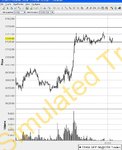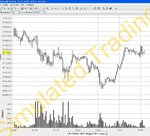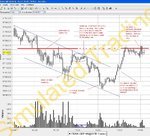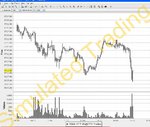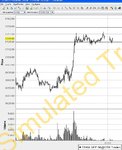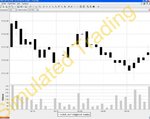firewalker99 said:
I try to enter a trade with three contracts. Of course it depends on the volatility of the moment and the probability of my entry. Then I place one fixed target at 2 times the ATR, another at 3 times and the last one I only exit when I see signs indicating the end of the move. From the moment my first one reaches it's target, I change the remainder stop at breakeven.
Does this seem too conservative?
That's up to you (you're going to hear me say that a lot). What matters is how much you milk out of what the market is making available to you. If this is how you do it and you're happy, then do it that way and be happy.
It is extremely difficult to get anywhere trading one contract. On the other hand, learning how to trade an instrument that trades by contract can be treacherous if one trades too many contracts too quickly.
Therefore, I suggest you work out your strategy using at least two. Backtest and forwardtest using two. Paper-trade real-time using two. But when you take the step into trading real money, trade only one contract for real and paper-trade the other. Using your example, "enter" with two, but enter for real with only one. That way, if you don't yet have your entries down, you haven't begun with a big-time loss right out of the gate. Then take your real profit at your first target and continue to paper-trade the second contract according to your plan.
Next, when you have your entries nailed and are confident in them (and are also confident about what you will do if they recoil on you and bite you in the ass), trade the two contracts for real and paper-trade a third. Follow this process until you're not only confident in your plan but confident in your ability to handle the unexpected.
I've experienced I've often lost a trade because my stop was too tight. How do you guys place a stop? A mental stop? A fixed stop? I use the average true range and depending on how high it is, I buy less contracts. If ATR is low, I buy more. Lately I've not been buying a lot because I've experienced quite a bit of losses so it's back to papertrading for me
Even though this is directed toward everyone, I'll chime in here. Where you place your stop depends on whatever it is you're trading and how you're trading it. For example, given what you're trading, if you're trading S/R and if you're trading BOs through S/R, then you have every reason to expect price to move in the anticipated direction IF you plotted S/R correctly. If you DIDN'T plot it correctly (which may be no fault of your own) and price snaps back at you, you don't want to sit there like a deer in headlights with a wide stop.
One way of determining whether a recoil is just noise or big trouble is to look at how far back price will travel before resuming its original direction (some call this the MAE, or Maximum Adverse Excursion), the idea being that if price moves past this, it's gone too far and you need to get out (and possibly reverse your position, but wait on that for now). For the NQ, which is what I trade, this is about four points, so I look at something around five for a stop. Whatever number you use, however, will depend on the results of your analysis of what you trade. (I should also point out that this changes over time, so you can't take any of this for granted. The MAE can change, just as the ADR can change. The ADR for the NQ, for example, used to be twice what it is now, and that means considerable adaptation. If any of this changes, you have to make changes as well.)
As for the ATR, I use the ADR instead (average daily range) since this is so predictable for the NQ and ES. However, it may not be so predictable for what you're trading. The ATR might have much more value for you. So, again, what you use depends on the results of your own testing.
But, as I've said, there's no big rush. Get it right, then you'll be able to make more progress faster. Otherwise, you'll be spinning your wheels much longer than necessary.
Db

